The Himalayan region, despite the very difficult terrain, is home to an estimated population of 50 million and another 450 million people live in the plains immediately to the south. The Himalayas have been subject to waves of invasions for millennia and you can see this history written in the faces of the people. The Central Himalayan region includes the state of Uttarakhand where I am working and this region is said to have been home to the Dom and Khasa people. The Dom were an Indo-Aryan group and the Khasa were a West-Central nomadic tribe which came into the Ganges plain from the northwest and spread across the range from Kashmir to Assam. In the central region today, the majority population are the Khasa people.
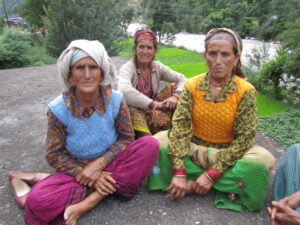 Life expectancy in the hill villages is reported to be in the mid- sixties, although on government sites the age of 71.7 years is reported for the state of Uttarakhand as a whole. The people look old ahead of their years and this is undoubtedly due to the hard rural life, diet and lack of heath care. The villagers were very curious about my age and kept saying that I must have had it easy – no comment!
Life expectancy in the hill villages is reported to be in the mid- sixties, although on government sites the age of 71.7 years is reported for the state of Uttarakhand as a whole. The people look old ahead of their years and this is undoubtedly due to the hard rural life, diet and lack of heath care. The villagers were very curious about my age and kept saying that I must have had it easy – no comment! 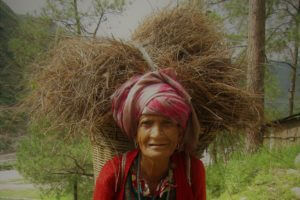 There is no doubting that village life is tough, from tending the rice paddies, gathering forage for mules and cows and let us not forget the walking – all the hill villages are just that – up a hill and 5 or more kilometres from the nearest shop, school or health facility. The people think nothing of a quick run down to the shop 5 km away and I have not seen anyone with a spare tyre here.
There is no doubting that village life is tough, from tending the rice paddies, gathering forage for mules and cows and let us not forget the walking – all the hill villages are just that – up a hill and 5 or more kilometres from the nearest shop, school or health facility. The people think nothing of a quick run down to the shop 5 km away and I have not seen anyone with a spare tyre here.
Some of the occupations locally:
 Wood gathering – with the monsoon rains comes the problem of landslides. These frequently cut rural roads and JCBs patrol to clear the smaller falls and larger landslides are dynamited. Big trees frequently come down at the same time and the local population chop up the wood. In the older houses, many people have a little clay wood burning fire which is used for cooking alongside the gas ring.
Wood gathering – with the monsoon rains comes the problem of landslides. These frequently cut rural roads and JCBs patrol to clear the smaller falls and larger landslides are dynamited. Big trees frequently come down at the same time and the local population chop up the wood. In the older houses, many people have a little clay wood burning fire which is used for cooking alongside the gas ring. 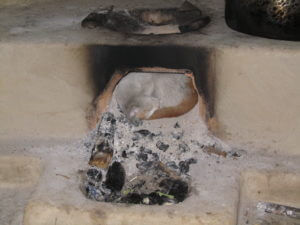 Very cosy for the cat! The traditional cremation of corpses is still carried out on a wooden funeral pyre and I wondered whether some enterprising soul had cornered the funeral pyre market. However, I was informed that when arranging a cremation that everyone will contribute wood for the fire. I was also curious about the practicalities of arranging a cremation during the monsoon. Most people in the UK have a problem lighting a bonfire for 5 November celebrations never mind a funeral pyre. The answer I was informed is “very dry wood”.
Very cosy for the cat! The traditional cremation of corpses is still carried out on a wooden funeral pyre and I wondered whether some enterprising soul had cornered the funeral pyre market. However, I was informed that when arranging a cremation that everyone will contribute wood for the fire. I was also curious about the practicalities of arranging a cremation during the monsoon. Most people in the UK have a problem lighting a bonfire for 5 November celebrations never mind a funeral pyre. The answer I was informed is “very dry wood”.
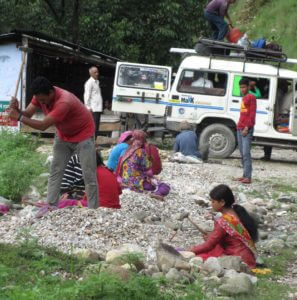 Road stone breaking – when I was walking one day I could hear this very regular tapping and when I came around the corner I found a scene from hell. A row of men, women and children all busily breaking rocks into road stone and hardcore for building. They had bits of rubber stapled together to protect their fingers and in the heat and humidity one can only imagine what a tough job this is.
Road stone breaking – when I was walking one day I could hear this very regular tapping and when I came around the corner I found a scene from hell. A row of men, women and children all busily breaking rocks into road stone and hardcore for building. They had bits of rubber stapled together to protect their fingers and in the heat and humidity one can only imagine what a tough job this is.
 Holy men – Indian sadhus are frequently seen in this area as they go on their pilgrimage to one of the many holy sites and temples. The Hindu sadhus wear saffron clothing and are widely respected by the rural population.
Holy men – Indian sadhus are frequently seen in this area as they go on their pilgrimage to one of the many holy sites and temples. The Hindu sadhus wear saffron clothing and are widely respected by the rural population.
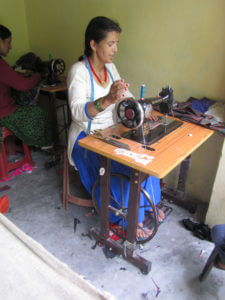 Seamstress – one of my colleagues very kindly brought me back a sari from Delhi and I had to get the little blouse (called a “choli”) made up by the local seamstress. This caused a great deal of interest with the village ladies and cost a whole 200 rupees. Everyone wanted to see the finished result and I had to enlist the help of my neighbour to show me how to put the whole ensemble on. It would seem that it is held together by a petticoat, a pin and a lot of luck. I then had to walk up the road from my house to the seamstress to show her and the whole thing turned into a bit of a fashion parade! People were very complimentary but I have to say that the Indian woman carries the sari with far more grace than I could ever muster.
Seamstress – one of my colleagues very kindly brought me back a sari from Delhi and I had to get the little blouse (called a “choli”) made up by the local seamstress. This caused a great deal of interest with the village ladies and cost a whole 200 rupees. Everyone wanted to see the finished result and I had to enlist the help of my neighbour to show me how to put the whole ensemble on. It would seem that it is held together by a petticoat, a pin and a lot of luck. I then had to walk up the road from my house to the seamstress to show her and the whole thing turned into a bit of a fashion parade! People were very complimentary but I have to say that the Indian woman carries the sari with far more grace than I could ever muster.
©Copyright overthehils.com 2017


Where is the selfie of you in a sari and your little choli?
Such a hard life for many. Do they get the same aches and pains we do, arthritis and the like?
John is installing a new washer dryer and on Friday a new fridge freezer arrives. Involves a ‘slight’ remodelling of the kitchen. I shall tell him not to moan about any stiffness or sore muscles.
Has the monsoon passed now? And is the temperature bearable? Humid or dry heat?
Thinking of you in your new environment!
Murielx
Hi Muriel. I am actually down from the hills of Darjeeling and in Siliguri. Long story but the political situation is such that no work up north. Temperature around 30C and humidity varies depending on rainfall but 96% not uncommon. Monsoon here will continue for another month. Lot of local flooding and landslides. The villagers are a very tough lot but do use the local pharmacy to treat any symptoms. However there is a downside to this as under-prescription is common and so resistance to ABs encouraged.